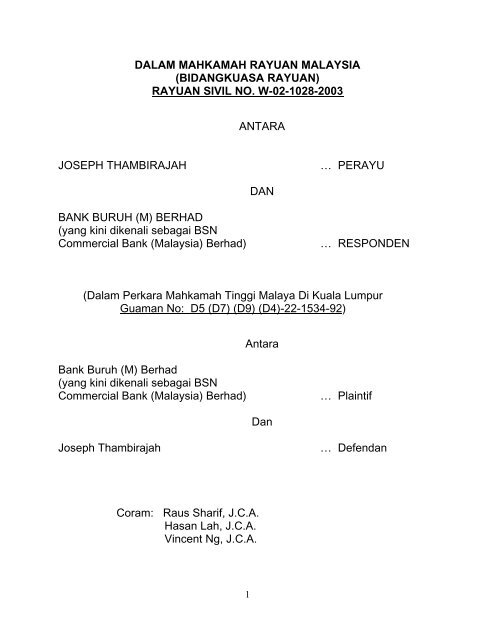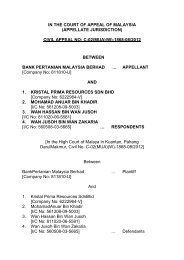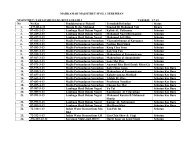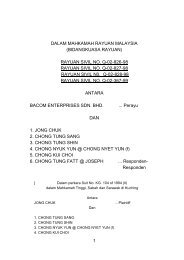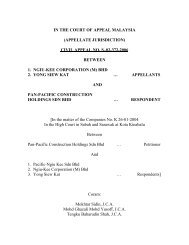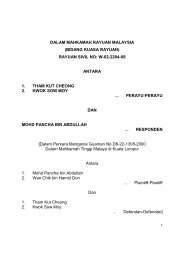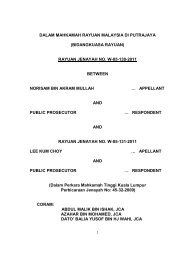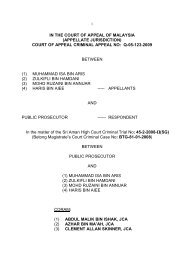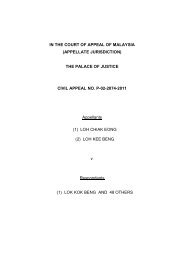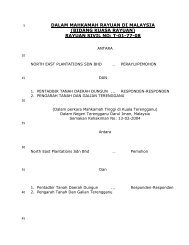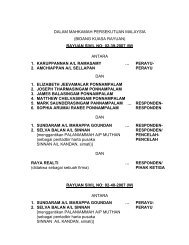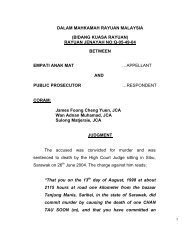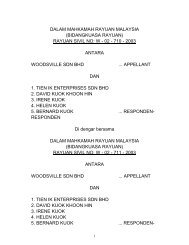rayuan sivil no. w-02-1028-2003 antara joseph thambirajah
rayuan sivil no. w-02-1028-2003 antara joseph thambirajah
rayuan sivil no. w-02-1028-2003 antara joseph thambirajah
You also want an ePaper? Increase the reach of your titles
YUMPU automatically turns print PDFs into web optimized ePapers that Google loves.
DALAM MAHKAMAH RAYUAN MALAYSIA<br />
(BIDANGKUASA RAYUAN)<br />
RAYUAN SIVIL NO. W-<strong>02</strong>-1<strong>02</strong>8-<strong>2003</strong><br />
ANTARA<br />
JOSEPH THAMBIRAJAH … PERAYU<br />
1<br />
DAN<br />
BANK BURUH (M) BERHAD<br />
(yang kini dikenali sebagai BSN<br />
Commercial Bank (Malaysia) Berhad) … RESPONDEN<br />
(Dalam Perkara Mahkamah Tinggi Malaya Di Kuala Lumpur<br />
Guaman No: D5 (D7) (D9) (D4)-22-1534-92)<br />
Antara<br />
Bank Buruh (M) Berhad<br />
(yang kini dikenali sebagai BSN<br />
Commercial Bank (Malaysia) Berhad) … Plaintif<br />
Dan<br />
Joseph Thambirajah … Defendan<br />
Coram: Raus Sharif, J.C.A.<br />
Hasan Lah, J.C.A.<br />
Vincent Ng, J.C.A.
Introduction<br />
JUDGMENT OF THE COURT<br />
1. This is an appeal against the decision of the High Court at<br />
Kuala Lumpur dated 30 October <strong>2003</strong>. The High Court had<br />
allowed the plaintiff’s claim (“the respondent”) against the<br />
defendant (“appellant”) whereby appellant was ordered to pay<br />
the respondent the sum of RM3,375,354.98 with interest at the<br />
rate of 11% per annum from 1 May 1992 till full settlement and<br />
costs.<br />
2. On 22 October 2007, we heard and allowed the appeal with<br />
costs. We <strong>no</strong>w give our reasons. But first the facts.<br />
Facts<br />
3. The respondent is a bank. By a letter of offer dated 12 January<br />
1978, the respondent availed loan facilities to Pembinaan<br />
Damo Sdn Bhd (“the principal borrower”). The appellant<br />
2
together with 2 others, Subhas Damodaran and Prakash<br />
Damodaran stood as guarantors. On 16 February 1979 two<br />
letters of guarantee were signed jointly and severally by the<br />
three guarantors for a total loan sum of RM868,000.00 availed<br />
by the respondent to the principal borrower.<br />
4. The principal borrower defaulted on the loan. On 23 December<br />
1980 the respondent issued a <strong>no</strong>tice of demand against the<br />
principal borrower and all the guarantors (“1 st <strong>no</strong>tice of<br />
demand”). Pursuant thereto, on 13 March 1981 the respondent<br />
filed Civil Suit No. C242 of 1981 (“the 1 st suit”) against the<br />
principal borrower and all the guarantors, to recover the loan.<br />
The appellant herein was the 4 th defendant in the 1 st suit.<br />
5. On 15 October 1981, the respondent obtained summary<br />
judgment against Subhas Damodaran and Prakash<br />
Damodaran, and on 25 May 1985, against the principal<br />
borrower. Thereafter, upon the lapse of about ten years since<br />
the filing of the 1 st suit, the appellant on 30 March 1991 filed an<br />
3
application (Enclosure 123) to strike out the respondent’s 1 st<br />
suit against him for want of prosecution.<br />
6. In response to Enclosure 123, the respondent on 4 June 1991,<br />
filed an application (Enclosure 126) for the 1 st suit to “be struck<br />
off with liberty, being an action prematurely commenced without<br />
a proper or valid <strong>no</strong>tice of demand on the defendant”.<br />
7. On 7 November 1991, at the hearing of Enclosure 123 and<br />
Enclosure 126 before the learned Senior Assistant Registrar,<br />
the respondent applied to amend Enclosure 126 to delete the<br />
words “struck off with liberty”. The amendment was allowed<br />
and order in terms was granted in respect of Enclosure 126.<br />
The Order dated 7 November 1991 reads as follows:-<br />
“Upon the application of the plaintiff AND<br />
UPON READING the Summons in Chambers<br />
dated 14 th day of June 1991 and the affidavit<br />
of Nadarajan s/o Govindasamy affirmed on<br />
the 13 day of June, 1991 and filed herein AND<br />
4
UPON HEARING Mr. K. Maniam of Counsel<br />
for the plaintiff and Miss Regine of Counsel for<br />
the 4 th Defendant IT IS ORDERED that the<br />
action against the 4 th Defendant be and is<br />
hereby with leave withdrawn and struck off as<br />
being an action prematurely commenced<br />
without a proper or valid <strong>no</strong>tice of demand<br />
made on the 4 th Defendant AND IT IS<br />
FURTHER ORDERED that the plaintiff do pay<br />
the 4 th Defendant costs as may be taxed.”<br />
With the above order, the appellant withdrew his Enclosure<br />
123.<br />
8. Thereafter, on 4 May 1992, about 11 years after the 1 st suit and<br />
judgment against the two guarantors, and 7 years after the<br />
judgment against the principal borrower, the respondent issued<br />
a<strong>no</strong>ther <strong>no</strong>tice of demand against the appellant for the sum of<br />
RM3,375,354.98 with interest thereon (2 nd <strong>no</strong>tice of demand).<br />
The 2 nd <strong>no</strong>tice of demand inter alia, stated:-<br />
5
“We are instructed that you were availed loan<br />
facilities at your request by our clients and that<br />
you had <strong>no</strong>t adjusted or repaid the<br />
outstanding together with arrears inclusive of<br />
interest in the sum of RM3,375,354.98.”<br />
9. On 8 June 1992, the respondent issued a<strong>no</strong>ther <strong>no</strong>tice of<br />
demand (“3 rd <strong>no</strong>tice of demand”) against the appellant inter alia<br />
stating:-<br />
“you had executed a guarantee indemnity in<br />
favor of our client for loan facilities granted to<br />
the above named party. The above party, we<br />
are instructed had failed and or ig<strong>no</strong>red or<br />
refused to settle the facilities which stands at<br />
RM3,375,354.98 inclusive of arrears and<br />
interest.”<br />
10. On 23 November 1992, the respondent filed a fresh action<br />
against the appellant in Suit D4-22-1534-92 (“2 nd suit”). Upon a<br />
6
full hearing, the learned High Court Judge gave judgment in<br />
favour of the respondent against the appellant with costs.<br />
Issues<br />
11. Before us, the following issues were raised by the appellant:-<br />
(i) Whether, considering that more than six years had lapsed<br />
since the respondent had issued to the appellant the 1 st<br />
<strong>no</strong>tice of demand, commenced the 1 st suit, and obtained<br />
judgment against the co-guarantors and principal<br />
borrower, the 2 nd suit against the appellant was time<br />
barred pursuant to s 6 (1) Limitation Act 1953.<br />
(ii) Whether considering that the respondent’s response to<br />
the appellant’s application to strike out the respondent’s<br />
1 st suit for want of prosecution was to file an application to<br />
strike out the 1 st suit ‘with liberty’ and thereupon at the<br />
hearing before the Senior Assistant Registrar of both<br />
applications, respondent applied to delete the words “with<br />
7
liberty” from their application in Enclosure 126, and<br />
thereupon withdrew Enclosure 123, there was in the<br />
circumstances in fact, law and equity a representation of<br />
closure and the respondent is precluded by issue<br />
estoppel from filling the 2 nd suit.<br />
(iii) Whether in any event,<br />
(a) the 2 nd <strong>no</strong>tice of demand by the respondent against<br />
the appellant was a valid <strong>no</strong>tice of demand which<br />
could commence a proper cause of action against<br />
the appellant considering that it did <strong>no</strong>t refer to any<br />
guarantee or make any reference to the appellant<br />
as a guarantor <strong>no</strong>r did it refer to any default by the<br />
principal borrower; and<br />
(b) if the 2 nd <strong>no</strong>tice of demand is construed as a<br />
demand under the ‘principal debtor clause’ in the<br />
guarantee, the same is barred under s 6 (1)<br />
Limitation Act 1953 as the cause of action against<br />
8
the principal borrower had commenced vide the 1 st<br />
letter of demand and/or the 1 st suit and in fact more<br />
than six years had lapsed since judgment was<br />
entered against the principal borrower.<br />
(iv) Whether a<strong>no</strong>ther <strong>no</strong>tice of demand dated 10 June 1992<br />
(“the 3 rd <strong>no</strong>tice of demand”) which was never tendered in<br />
court as a court exhibit and never pleaded and was only<br />
an ID can properly be considered by the court as<br />
constituting a proper and valid <strong>no</strong>tice of demand to<br />
commence a cause of action against the appellant.<br />
(v) Whether the respondent had proved their claim for<br />
RM3,375,354.98 with interest thereon at 11% per annum<br />
from 1 May 1992 till date of settlement with costs.<br />
(i) Issue of Limitation<br />
12. It was submitted by learned counsel for the appellant that 2 nd<br />
suit filed by the respondent is time barred by virtue of section 6<br />
9
(1) of the Limitation Act 1953 which provides that actions<br />
founded on a contract or agreement shall <strong>no</strong>t be brought after<br />
the expiration of 6 years from the date which the cause of<br />
action occurred. Learned counsel pointed out that the cause of<br />
action against the appellant occurred either from 1 st <strong>no</strong>tice of<br />
demand dated 23 March 1980 or when the 1 st suit was filed on<br />
11 March 1982. Since the 2 nd suit was only filed on 23<br />
November 1992, more than 11 years later, it would be barred<br />
by limitation.<br />
13. Learned counsel for the respondent submitted that time only<br />
begins to run from the date of demand made against the<br />
appellant. The demand was sent to the appellant on 4 May<br />
1992 and 10 June 1992. Hence, the 2 nd suit which was filed on<br />
29 August 1992 was <strong>no</strong>t time barred. The learned counsel<br />
further submitted that the 1 st suit can<strong>no</strong>t constitute a sufficient<br />
<strong>no</strong>tice of demand because the appellant resisted the claim<br />
under the 1 st suit claiming that there was <strong>no</strong> demand made<br />
against him and the action was withdrawn.<br />
10
14. The learned High Court Judge agreed with the respondent.<br />
With utmost respect we disagree. Such a finding by the<br />
learned High Court Judge would be in contradiction to his own<br />
finding on clause 14 of the guarantee relating to the “principal<br />
debtor clause” when he held that:<br />
“It is <strong>no</strong>w settled that the presence of such a<br />
clause in the guarantee obviates the necessity<br />
for a creditor to make a demand to a<br />
guarantor as the guarantee is <strong>no</strong> longer a<br />
collateral agreement and the issuance of the<br />
Writ is a demand in itself (see: Perwira<br />
Habib Bank Malaysia Bhd v Floorwall<br />
Furnishing Sdn Bhd & Ors. – Civil Suit No:<br />
C23-2092-86 Kuala Lumpur High Court). In<br />
that case the Court ruled that the fact that<br />
defendant 3 had been served with only a<br />
carbon copy of the <strong>no</strong>tice was immaterial to<br />
establish his liability under the guarantee by<br />
virtue of the presence of clause 14 – relating<br />
11
to “principal debtor clause” in the guarantee<br />
itself. The same ruling was made by the<br />
same judge (Her Ladyship Siti Norma Yaakob<br />
J) in Credit Corporation (M) Bhd v Choi<br />
Seng & A<strong>no</strong>r, Civil Suit No: C2-22-5650-86<br />
Kuala Lumpur High Court, and Arab<br />
Malaysian Finance Bhd v Kemajuan<br />
Mugiland Sdn Bhd & Ors, Civil Suit No.<br />
C3236 of 1985, Kuala Lumpur High Court.<br />
In the first place, based on the above<br />
authorities, the Court is convinced that the<br />
plaintiff need <strong>no</strong>t send any <strong>no</strong>tice of demand<br />
to the defendant in the present case by virtue<br />
of the presence of Clause 14 – relating to<br />
“principal debtor clause” in the guarantees.<br />
Service of the Writ and Statement of Claim<br />
itself on the defendant (as guarantor) is<br />
sufficient <strong>no</strong>tice of such a demand having<br />
been made. However, in the present case,<br />
12
the plaintiff has sent the <strong>no</strong>tice of demand<br />
dated 4.5.1992 2 nd case identifying the<br />
defendant as the “principal debtor pursuant to<br />
the guarantees. This is a perfectly valid <strong>no</strong>tice<br />
and the suit commenced against the<br />
defendant based on this <strong>no</strong>tice is also<br />
actionable in law.”<br />
15. We are of the view that based on the above principle of law,<br />
rightly accepted by the learned High Court Judge, it would<br />
accordingly follow that the respondent’s cause of action against<br />
the appellant had occurred on the date when the 1 st suit was<br />
commenced against the appellant, i.e. on 11 March 1981.<br />
Since the 2 nd suit was filed more than 11 years later, the same<br />
was clearly time barred pursuant to section 6 (1) of the<br />
Limitation Act 1953. Further, even if the guarantees are to be<br />
considered as “on demand guarantees”, it must be pointed out<br />
that in this case the respondent had launched the 1 st suit<br />
against the principal borrower and all the three guarantors,<br />
appellant included, on the basis of the 1 st <strong>no</strong>tice of demand<br />
13
dated 23 December 1980. Based on this cause of action, final<br />
judgment had been entered against the principal borrower and<br />
two of the guarantors. In the circumstances it would be<br />
untenable for the respondent to suggest that for the appellant<br />
alone, the cause of action did <strong>no</strong>t accrue with the 1 st <strong>no</strong>tice of<br />
demand but was held in abeyance or postponed for about 11 ½<br />
years until it issued the 2 nd <strong>no</strong>tice of demand on 4 May 1992.<br />
16. In Nik Che Kih @ Nik Soo Koh v Public Bank [2001] 2 AMR<br />
1620, the Court of Appeal affirmed the principle that for the<br />
purpose of limitation, time began to run from the earliest date<br />
on which the creditor could have brought an action. In that<br />
case the Bank issued a total of three demands –<br />
“The first demand was made on April 2, 1986.<br />
Arising out of the first demand, the respondent<br />
sued the principal debtor i.e. Nik Seng<br />
Development Sdn Bhd. Strangely e<strong>no</strong>ugh<br />
<strong>no</strong>ne of the guarantors were included in that<br />
suit. Then on May 15, 1986, the respondent<br />
14
issued a second demand against the principal<br />
debtor and the appellant and the two other<br />
guarantors. Some six years later the<br />
respondent withdrew the suit against the<br />
appellant and the two other guarantors without<br />
assigning any reasons for the withdrawal. On<br />
July 20, 1993 the respondent issued a third<br />
demand and consequently filed this present<br />
suit against the appellant on June 21, 1996<br />
i.e. about three years later. The issue before<br />
the court is when did the time begin to run for<br />
the purpose of s 6 (1) (a) of the Limitation Act<br />
1953.”<br />
17. The Court of Appeal held that the liability of the principal debtor<br />
as well as that of the guarantor arose from the first <strong>no</strong>tice of<br />
demand dated 2 April 1986. Similarly, in the present case, it is<br />
our judgment that liability of the appellant, and correspondingly<br />
the respondent’s cause of action arose from the 1 st <strong>no</strong>tice of<br />
demand dated 23 December 1980, which launched the 1 st suit<br />
15
against the principal borrower and the guarantors including the<br />
appellant, on 11 March 1981. In any event, if the cause of<br />
action did <strong>no</strong>t accrue on 23 December 1980, then it certainly<br />
did on 11 March 1981. Since the 2 nd suit was only filed on 23<br />
November 1992, it would be barred by limitation.<br />
(ii) Issue of Estoppel<br />
18. It is the contention of the appellant that the respondent is<br />
estopped from bringing 2 nd suit as the 1 st suit was withdrawn by<br />
the respondent. The learned High Court Judge however<br />
disagrees. He held that the withdrawing of the 1 st suit did <strong>no</strong>t<br />
absolve the respondent’s claim against the appellant as the 1 st<br />
suit was withdrawn with the leave of the court. The respondent<br />
therefore is <strong>no</strong>t estopped from filing the 2 nd suit.<br />
19. With respect, we are of the view that the issue of estoppel must<br />
be decided on the facts that unfold. It is clear from the facts as<br />
narrated earlier that the appellant withdrew Enclosure 123<br />
because of the deletion of the words “struck off with liberty” in<br />
16
the respondent’s Enclosure 126. In the circumstances, to allow<br />
the respondent to file a fresh action based on the same or<br />
substantively the same facts would be unjust and grossly<br />
prejudicial to the appellant.<br />
20. In fact, the same was held in Ng Hee Thong v Public Bank<br />
Berhad [2000] 2 MLJ 31. In that case, two guarantors were<br />
sued by the bank for a loan advanced to the principal borrower.<br />
The bank’s application for summary judgment against the<br />
guarantors was allowed by the High Court. The guarantors<br />
then appealed to the Court of Appeal which allowed the appeal<br />
and directed the suit to be tried. At the High Court the bank<br />
instead, filed an application for leave to withdraw its claim<br />
against the guarantors with liberty to file a subsequent action<br />
against the guarantors based on the same cause of action.<br />
The reason for wanting to discontinue their claim was the<br />
<strong>no</strong>tices of demand against the guarantors were <strong>no</strong>t sent to their<br />
proper addresses. The High Court allowed the bank’s<br />
application. The guarantors appealed to the Court of Appeal<br />
which allowed the appeal and set aside the order of the High<br />
17
Court. The Court of Appeal gave leave to the bank to<br />
discontinue upon the term that <strong>no</strong> fresh action should be<br />
brought on the same cause of action based on the same or<br />
substantially the same factual situation.<br />
21. In the present case, the appellant is on a stronger ground. The<br />
respondent itself had applied to delete the words “struck off with<br />
liberty” which is a clear representation by the respondent that<br />
there would be closure of the matter. Thus, we are in<br />
agreement with the appellant that the doctrine of estoppel as<br />
expounded in Boustead Trading [1985] Sdn Bhd v Arab<br />
Malaysia Merchant Bank [1995] 3 MLJ 331 is applicable in<br />
this case and the respondent ought to be estopped from filling<br />
the 2 nd suit.<br />
(iii) 2 nd letter of demand<br />
22. We are also of the view that even if a demand is a necessary<br />
precondition to commence an action against the appellant, the<br />
2 nd letter of demand can<strong>no</strong>t be construed as a valid <strong>no</strong>tice of<br />
18
demand. This is because it failed to identify any guarantee or<br />
guarantor but instead wrongly stated that the appellant was<br />
“availed loan facilities at your request by our client and that you<br />
had <strong>no</strong>t adjusted or repaid the outstanding together with arrears<br />
inclusive of interest in the sum of RM3,375,354.98”. It is our<br />
judgment that the 2 nd letter of demand can<strong>no</strong>t be construed as<br />
valid demand as envisaged by the guarantee documents. Even<br />
the learned High Court Judge, appears to have doubt, as to the<br />
validity of the 2 nd <strong>no</strong>tice of demand since he had to resort to the<br />
3 rd <strong>no</strong>tice of demand.<br />
(iv) 3 rd <strong>no</strong>tice of demand<br />
23. The learned High Court Judge was of the view that the 2 nd<br />
<strong>no</strong>tice of demand is <strong>no</strong>t necessary in view of the presence of<br />
clause 14 relating to principal debtor clause in the guarantees.<br />
However, in discussing the 2 nd <strong>no</strong>tice of demand, he made<br />
reference to the 3 rd <strong>no</strong>tice of demand. He said “in any event the<br />
plaintiff has also send the <strong>no</strong>tice of demand to the defendant<br />
(as a guarantor) on 10.6.1992”. We are of the view that the 3 rd<br />
19
letter of demand can<strong>no</strong>t be considered at all because it was <strong>no</strong>t<br />
tendered in count by any witness of the respondent. It was only<br />
an identification document (ID) in the Non Agreed Bundle and<br />
was never converted to a court exhibit. In Soo Hong & Leong<br />
Kew Moi v UMBC [1997] 1 MLJ 690 the Court of Appeal held:-<br />
“During the course of the trial, various<br />
documentary exhibits were referred to by both<br />
sides and marked as exhibits to be identified<br />
(ID) since the admissibility of such documents<br />
were objected to by either side on the ground<br />
that the makers were <strong>no</strong>t called. I rule that<br />
since these documents were <strong>no</strong>t strictly<br />
proved as required by s 73 (a) of the Evidence<br />
Act 1950 thereby deprives the opportunity to<br />
test the authenticity of their contents, such<br />
exhibits remain inadmissible.”<br />
20
Similarly in this case, the 3rd letter of demand is an ID and had<br />
never been converted to a court exhibit. It can<strong>no</strong>t be relied<br />
upon as an exhibit.<br />
(v) Whether the respondent had proved their claim<br />
24. In this case the loan guaranteed was for RM868,000.00. But in<br />
the 2 nd letter of demand and the 2 nd suit, the respondent<br />
claimed RM3,375,354.98. The amount is in serious dispute.<br />
However, the learned High Court Judge concluded that the<br />
respondent had successfully proven its case against the<br />
appellant. Learned counsel for the respondent invited us <strong>no</strong>t to<br />
disturb the finding of the learned High Court Judge as the<br />
finding is fact driven. We declined the invitation. No doubt the<br />
finding of the learned High Court Judge is fact driven, but the<br />
calculation as to how the amount of RM3,375,354.98 was<br />
arrived at had <strong>no</strong>t been clearly stated in particular, the amount<br />
of overdue interest or computation of the interest. In fact the<br />
main witness for the respondent, PW1 in cross-examination<br />
admitted:-<br />
21
(a) the computation and interest charges had commenced<br />
before September 1977 up to January 1978 although the<br />
facility (the subject of the guarantee) was released only<br />
on 6 February 1978;<br />
(b) before the facility was released on 6 February 1978 there<br />
was already a debit in the account of RM334,085.91;<br />
(c) the total interest computed from September 1977 up to<br />
June 1992 was RM2,768,905.65;<br />
(d) the interest throughout was computed on a compound<br />
basis;<br />
(e) ledger for a period of three years from 28 December 1979<br />
to 31 December 1982 was <strong>no</strong>t produced;<br />
(f) the sum of RM22,750.00 was debited ostensibly for<br />
disbursement and professional fees for the respondent’s<br />
solicitors.<br />
22
25. The learned High Court was aware of the above. However, he<br />
relied on the summary account in ID3-F by virtue of section 4<br />
and 5 of Bankers Book (Evidence) Act 1949. However, ID3-F<br />
was never converted as a court exhibit, and the maker of D3F<br />
is unk<strong>no</strong>wn. Neither PW1 and PW2 had explained the missing<br />
ledgers for the two years and neither witness testified that they<br />
had mounted a search for these missing ledgers. PW2 testified<br />
that he did <strong>no</strong>t go to the correctness of those documents. He<br />
did <strong>no</strong>t examine any copy of the documents with the original<br />
entry in the bankers book and the same is correct. Thus, he<br />
was unable to answer as to the missing ledgers between 28<br />
December 1979 to 31 December 1982.<br />
26. In the circumstances, we are <strong>no</strong>t in agreement with the learned<br />
trial High Court Judge’s finding that the respondent had<br />
successfully proven its case. It is our judgment that such a<br />
finding is clearly a finding <strong>no</strong>t supported by evidence.<br />
23
27. For the reasons aforesaid, we allowed the appeal with costs<br />
here and below. Deposit for this appeal to account of taxed<br />
costs.<br />
Dated 28 December 2007.<br />
Raus Sharif<br />
Judge<br />
Court of Appeal Malaysia<br />
Counsel for the appellants: En. Ramdas Tikamdas<br />
Solicitors for the appellants: Tetuan Siva, Ram & Associates<br />
Counsel for the 1 st respondent: En. Arunachalam Ramiah<br />
Solicitors for the 1 st respondent: Tetuan Arun & Co.<br />
24


